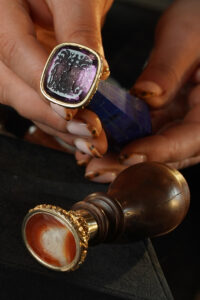A rare 200-year-old desk seal belonging to Sir Walter Scott could fetch up to £18,000 when it goes under the hammer this week.
The finely carved hand seal is from Scott’s personal desk seal at Abbotsford House in the Scottish Borders and is believed to date back to his knighthood in 1820.
It is set in lapis lazuli, gold and amethyst stones and bears the writer’s family armorial.
A prolific writer of letters, it is likely this seal was also used in correspondence to King George IV.
This led to Scott organising a royal visit to Scotland, complete with tartan pageantry which resulted in the elevation of the kilt to national dress.
The seal forms part of the Matrix Collection of desk seals which was gathered over several decades by avid collector, the late David Morris.
His collection of 100 seals will be sold at Lyon & Turnbull’s specialist sale on May 19.

Sir Walter Scott desk seal. Picture Stewart Attwood/Lyon & Turnbull
Another prominent seal in the sale was commissioned by The Edinburgh Theatrical Fund.
This important piece of history from the Enlightenment period was made in 1819 and is mounted in gold, boxwood and agate.
It is estimated at between £1,500 and £2,500.
The seal of the Forth & Clyde Canal Company is also on sale, which dates back to 1768 and is engraved with its emblem.
The firm was responsible for the construction of a canal route between the Firth of Forth and the Firth of Clyde which enabled boat travel from Edinburgh to Glasgow.
It is expected to fetch between £400 and £600.
Lyon & Turnbull specialist Kier Mulholland, said: ‘This is an exceptional collection of historic and elegant objects.
‘David Morris went to great lengths to acquire these significant works, which offer a glimpse into a time when family crests and armorials were of great importance.
‘Perhaps most tantalising is that each piece tells us a different story, which is the reason they were collected by Mr Morris.’
Wax seals were widely used from the Middle Ages until the nineteenth century when letters could be safely sealed with glue.
Seals have recently undergone something of a revival, with a new generation of enthusiasts using them for wedding invitations and other special occasion correspondence.
Read more news and reviews on Scottish Field’s culture pages.
Plus, don’t miss the June issue of Scottish Field magazine.
TAGS

